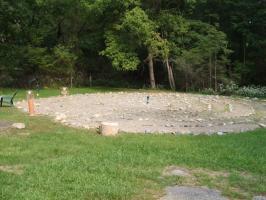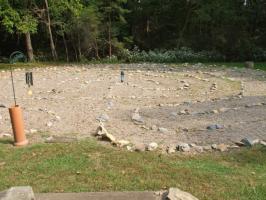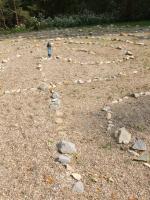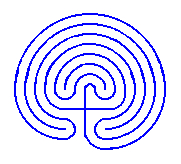Prayer Labyrinths
The main reason that I chose to go to the Sisters of St. Joseph Retreat Center for my spiritual retreat was that their website said that they had a labyrinth. Their site says: The St. Joseph Center now offers its visitors a unique prayer opportunity. Guests can pursue quiet thoughts while walking through the labyrinth. Walking meditation is a form of “body prayer,” a way of using the whole body.
“That sounds interesting,” I thought. I had images of some kind of bushes or hedges planted and trimmed in a way to create a maze of sorts — or maybe even something made of stone! I could imagine walking through the labyrinth and having a larger sense of isolation that would come from being immersed in the maze. It sounded like a very cool experience.
“Spiritual” Labyrinths
But that’s not an accurate picture of this kind of labyrinth. This kind of labyrinth is a twisting, turning path laid out on the ground that you follow. Here are a few of shots of the labyrinth at the St. Joseph Center, and a little diagram showing the path.
This type of labyrinth is called a “cretan” labyrinth. That’s the name given to that particular pattern. This webpage talks more about these kinds of labyrinths, and there is a website out there called www.labyrinthsociety.org.
When I first walked up to the labyrinth (still looking for some kind of three-dimensional maze built from hedges or something similar) I wondered to myself “is there another maze around here somewhere?” I had never heard of this kind of labyrinth before. I mean it isn’t anything like the one in the movie Labyrinth at all!
And if you do much searching on the subject, you’ll find that most material on labyrinths isn’t really oriented around prayer. My calling this a “prayer labyrinth” article is a bit of a misnomer. It seems that most of the stuff out there on labyrinths is a bit new-agey — searching yourself to “find your center,” etc. In fact, while I was at the retreat center, I found on one of the tables in the library the August 2005 issue of the “St. Anthony Messenger” (their website is http://www.americancatholic.org). The cover article was titled “Labyrinths, the inward journey.”
Finding this magazine in the context I found it, I thought it would have information on how a Catholic should approach a labyrinth. I expected to read certain cautions against mysticism along with tips on how to best use this “spiritual tool.” But I was surprised to find most of the information to be quite ecumenical and spiritually vague. Here is some of the questions they recommend that you ask yourself while walking the labyrinth:
- What am I experiencing?
- Are there any surprises?
- Do I feel lost?
- How do I parallel this with my own life story?
- Where am I on my journey at this moment in time? Am I at the beginning or far from the center?
- Have I found the center? The treasure? How does it feel?
Sounds awfully new-agey. These questions are all subjective questions about how the walker is feeling. It just surprised me to see this in a Catholic publication. Now I’m guessing there are theologically conservative and theologically liberal publications serving the Catholic church just as there are in the Protestant world. I just viewed Catholicism as much more monolithic, I guess. I mean, I can’t imagine this reflects Catholic doctrine as approved by Rome.
Apparently there has been a resurgence in popularity of these labyrinths across the country. The article in the “St. Anthony Messenger” was kind of interesting, but again, very spiritually vague.
[11/29/2005] Update: Some kind person emailed me a copy of this article: “An Ancient Structure To Beckon Gods”? which appeared in November of 2005 on the New Oxford Review website. Since I’m not a Catholic, I’m not all that familiar with this site, but the article is critical of the labyrinth article in the “St. Anthony Messenger” that I referred to above. It takes a position that seems much more in line with what I would have expected Catholic teaching to say. The article ends with
In a sidebar, [the St. Anthony Messenger] tells you how “to locate a labyrinth near you.” Thanks, SAM, for leading your 300,000 unwary Catholic readers into the fever swamps of the pagan goddess and the New Age.
That certainly seems to me to be a more appropriate position for the Catholic church to take. I’m glad to see that there are Catholic apologetic groups out there standing up for their doctrine — not that I agree with all Catholic doctrine of course.
“Spiritual tools”
I was discussing going to a Catholic retreat center with a buddy of mine and we started discussing the various things I usually associate with Catholicism: prayer benches, kneelers, busts and paintings of saints, the labyrinth I was looking forward to (although still with a misinformed image in mind), etc. He said to me, “Ah yes, they do like the tools.”
I think that’s a valuable thing to realize. These “spiritual objects” that Protestants typically view with suspicion can be simply viewed as tools to help in your pursuit of spiritual discipline. In reality, we Protestants use several kinds of “tools” as well: prayer lists, devotional books like “Our Daily Bread” or “Tabletalk”, “Read through your Bible in a year” plans, etc. It just seems that Catholics embrace the tools to a degree that makes a lot of Protestants uncomfortable. I’ve been taught for years that images of saints and Mary are actually idols, for instance.
Without getting into the theology behind praying to Mary or dead saints (which I do think is a non-Biblical idea) I don’t see the harm in using various “spiritual tools” that are found to be helpful. As an example, I’m working on plans so that I can build a prayer bench of sorts for when I just feel that I need/want to be on my knees in prayer. Honestly, that would have seemed a little weird to me a few years ago.
Another thing that I’m using now that I wouldn’t have thought was a good idea years ago is a prayer book. I am very affected by the prayers written in The Valley of Vision. I find that many times the prayers of these puritan era saints are very well thought out and on point to what I’m wanting to pray about.
So in the area of “spiritual tools,” what’s the usefulness of a labyrinth? Well, I gave it a shot. I walked the labyrinth slowly while praying through some topics in The Valley of Vision. I didn’t find it any more helpful to my prayer focus than a walk elsewhere would be. In fact, since the path of the labyrinth is so twisty, it was a bit of a distraction at times. I think I’m better focused in prayer when I’m just on a normal walk.
From what I’ve read, most people who find a labyrinth helpful are probably looking for something a bit mysterious and mystical, not a real prayer time with God. Why else would the shape of the path be significant? The St. Joseph Retreat Center website says It is a classic design of seven cycles and seven 180-degree turns, symbolizing the seven stages of life that many traditions speak of. So I guess the path can be helpful to some — but it seems it is only pointing people towards some spiritually vague “stages of life” kind if idea.
It’s probably true that this is a helpful tool to some people. But I question its role as a productive and useful tool to professing Christians.



